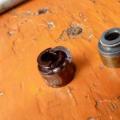Checking gear gear
You must check after you finally collect and adjust the gearbox rear bridge. To do this, paint the teeth of paint. It is not worth using too liquid paint for these purposes - it will grow and blocked the teeth, too thick - does not hang out of the gaps between the teeth. Rotating the lead gear in both directions, slowing down at the same time.
Make these manipulations until it designates a clear contact spot. Checking the installation of the gear and side gap in the engagement is completed by obtaining the correct contact stain.
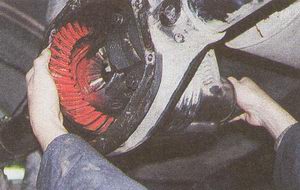
If during the adjustment there was a need to move the drive gear, then this can be done when the thickness of the adjustment setup is changed, which are installed between the end of the inner ring rear Bearing The lead gear and the end of the gear.
Spot of contact of the teeth in the gears of the rear axle gear:
Rear reducer VAZ 2106 - a very reliable knot of this legendary car, quite rarely failing. Basically, the cause of breakage is incorrect operation or untimely maintenance. Factory defects are not excluded, as well as repairs due to the large wear of parts associated with the huge mileage of the car.
Characteristic rear gearbox malfunctions
Most often, the breakdown of this vehicle transmission element is related to the development of the resource of some parts requiring the subsequent replacement. The main causes of the rear axle reducer are:
- wear of the shank salinine;
- wear of the bearing shank or differential;
- breakdown of differential elements;
- wear or breakdown of parts of the main pair.
Signs of a breakdown of the rear bridge of the VAZ 2106 cannot be noticed. Leather oils from a gearbox or a characteristic "curving" sound, coming from this node when moving immediately give out the cause of the fault. And if the leakage of transmission oil is easy to eliminate, simply replacing the shank gland, then the noise emanating from the broken transmission is not so easy to understand.
First, it is necessary to check whether the noise disappears when the car is moving. If disappears, then the reason is definitely in main pare. gearbox. If the noise or buzz remained, the cause of the malfunction, most likely, is a breakdown of the shank bearing or differential. The principle of this simplest diagnostics is that when driving, there is no power contact of the elements of the main pair, and accordingly, their condition does not affect the buzzing buzz.
First of all, it should be noted that most often the main pair is exposed to elevated wear due to low level Oil. Insufficiently blurred details of the gearbox, naturally, are subjected to strongest thermal and friction overloads. In turn, the drop in the oil level occurs when a faulty seal, which comes in disrepair with a weakly tightened nut of the shank. The second reason that often leads to the replacement of the VAZ 2106 gearbox is an increased load on the transmission, occurring during long-term operation of the vehicle with a large overload. Thirdly, it is impossible to exclude the factory defect of the details mounted on the rear gearbox, the price of which is unreasonably high.
Repair of the rear axle and replacement of gearbox
Depending on the cause of the breakage, to restore the operation of the transmission, the following repair work may be needed:
- replacement of the gauge of the Reducer VAZ 2106;
- replacement and adjustment of the main pair;
- defecting of the bearing of differential and shank and their replacement if necessary;
- replacing the Reducer VAZ 2106.
Repair with the replacement of bearings and (or) elements of the main pair of gearbox - very complex in technical Plan. It requires special knowledge and tools in the process of adjusting the VAZ 2106 gearbox. As a rule, this node is regulated either at the factory or in specialized workshops. Looking at the video about the repair of the VAZ 2106 gearbox, you can make sure about it. Meanwhile, to prevent the breakdown of this element of the transmission, it is necessary to monitor whether the shank nut is tightened, and there is no leaks from seals.
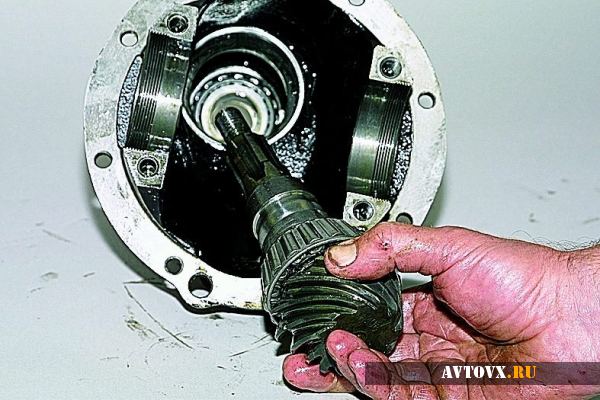
The replacement of the seal of the reducer of the VAZ 2106 is necessary in case of leaks from the transmission oil. Simple nuts nuts here do not do. Therefore, before you know how to adjust the VAZ 2106 reducer, learn to replace the drowned gland. For repair work You will need:
- a set of horn wrench and end heads;
- elementist for removing the gland;
- litol-24 lubrication;
- mandrel for installing a new gland;
- hex key for unscrewing drain plug;
- a hammer;
- capacity for draining oil;
- transmission oil.
Work on replacing the rear axle reducer gland is best done on the observation pit.
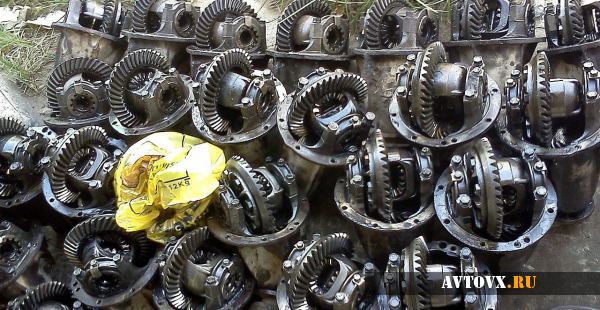
The replacement is made in the following order:
- We unscrew the cork to drain the oil, and, substituting the container, drain it.
- Unscrewed cardan Val. From the flange of the rear axle gearbox.
- We unscrew the flange nut, counting the exact number of revolutions, write the value.
- Remove the flange. It is usually removed easily, but you can easily knock on it with a hammer when it is dense installation.
- If there is shells on the surface of the flange, or the production at the seafront site, it is replaced.
- Using the puller, we remove the woven rear bridge seal of the VAZ 2106 reducer.
- A new gland with a lithol-24 consistent lubricant to facilitate its installation.
- With the help of a mandrel, easy blows hammer put the gland in place.
- We install the flange and tighten the nut at exactly the number of revolutions that we recorded.
- We attach the cardan shaft to the rear bridge.
- Pour oil into the VAZ 2106 gearbox to the level of the fuzzy neck. It is recommended to use transmission oil famous manufacturers. We can use a molybdenum additive to it to reduce friction between the details.
After repair, it is also necessary to check the condition of the Sapunka, and, if necessary, clean it. If it became necessary to fully replace this node, then you need to know that the gear ratio of the Reducer of the VAZ 2106 is 3.9, the vehicle speedometer readings are guaranteed. About how to remove the Reducer VAZ 2106 read in other articles on our website.
By installing the Reducer VAZ 2106 on the workbench, the key "on 10" turn the two bolts of attachment of the locking plates of nuts of the differential bearings and remove the plates
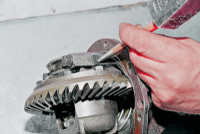
Core apply labels to bed and the corresponding bearing cover to install covers in its place when assembling

The key "on 14" turn the bolts of fastening the bearing caps
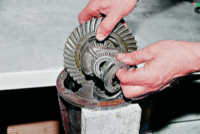
Take out the outer rings of bearings and adjusting nuts from the case of the differential. If the bearings do not change, then we mark the outer rings in order not to confuse them in places when installed, because Bearings individually worked and unwanted them undesirable.
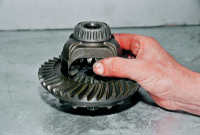
Check the absence of radial backlats in gearbox gear
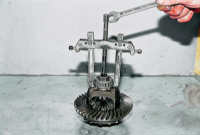
The puller sprink the inner rings of conical bearings
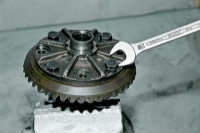
The key "at 17" turns over eight bolts of fastening the driven gear to the differential body and remove it

Satellite axis with a beard
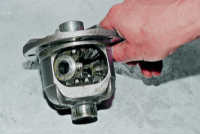
We turn the gears of the semi-axle and take out gears satellites
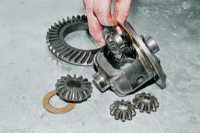
We take out the gears of the semi-axes with adjusting washers, placing their position
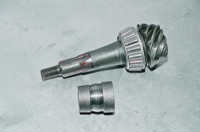
We take out the drive gear and deformed spacer sleeve out of the Carter. When assembling the gearbox we replace it with a new one
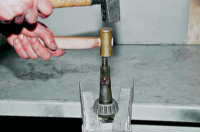
Flickering made of soft metal kill an inner ring of a conical bearing with a leading gear shaft

Under the bearing installed the adjusting ring, providing the right mutual location of the gear the main transfer
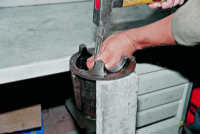
Suitable tool knock out the outer rings of conical bearings from crankcase
Assembling Reducer VAZ 2106
Details of the gearbox are thoroughly rinsed in kerosene and carefully inspect. In case of damage to at least one tooth (chipping, waves, risks, jackets on working surfaces) replace the gears with new ones. The face between the vertices and the working surfaces of the teeth driven gear should be sharp. If the slightest fears or roundings are visible - the main pair is replaced with a new one. Minor damage to the satellite axis, neck gear semi-axes and their seating holes by eliminating the shallow skin with the subsequent polishing. When assembling the cuff, the flange nut and the spacer sleeve is replaced by new ones.
If the assembly of the Reducer of the VAZ 2106 will be carried out in the previous crankcase, the change in the thickness of the adjusting ring of the drive gear can be calculated as the difference in the deviations of the size of the manufacture of old and new gears. The deviation in the amount of the sign "" or "-" in the hundredths of the millimeter is engraved on the shaft of the lead gear. For example, on the old gear is engraved -12, and on the new 4. The difference of two amendments will be 4 - (- 12) \u003d 16. So, the new adjusting ring should be 0.16 mm thinner than the old one. With the reverse correction ratio (on the old 4, and on the new -12), the ring should be 0.16 mm thicker. For a more accurate determination of the thickness of the adjusting ring, we make a device from the old lead gear.
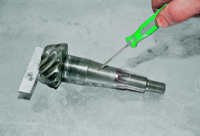
We weld the plate with a length of 80 mm and carry it into size 50-0.02 mm relative to the plane under the bearing. A factory number and deviation in size engraved on the conical part of the shaft. Planting Under bearings, we calculate (you can handle fine skin) to a sliding fit. We will prescribe the outer rings of the front and rear bearings in the crankcase. On the manufactured device, we set the inner ring of the rear bearing and insert the device to the crankcase. Install the inner ring front bearing, the flange of the lead gear and tighten the nut with a moment of 0.8-1.0 kgf.m.
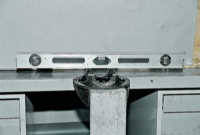
I exhibit Carter in a horizontal position by level
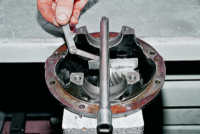
In the bed of bearings, we put a round smooth rod (extension from the set of end heads) and flat probe determine the size of the gap between it and the plate of the device. The thickness of the adjusting ring is determined as the difference between the size of the gap and the deviation of the size of the new gear (taking into account the sign). For example, the magnitude of the gap is 2.8 mm, and the deviation of the size of the gear -15. It means that it is necessary to install the adjusting ring with a thickness of 2.8 - (- 0.15) \u003d 2.95 mm.
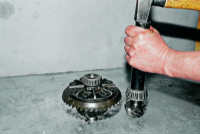
We set the adjusting ring of the required thickness to the shaft and using the segment of the suitable size of the appropriate size we press the inner ring of the bearing and insert the shaft into the crankcase. We establish a new spacer sleeve, the inner ring of the front bearing, cuff and flange of the lead gear.
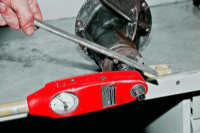
We gradually tighten the nut with a torque wrench until the moment of 12 kgf.m.
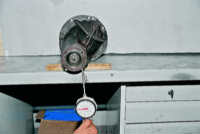
We define the moment of turning the shaft of the lead gear. To do this, on the neck flange tightly wrap in a few revolutions, a durable thread and a dynamometer to it. The force in which the flange will begin to turn evenly, should be 7.6-9.5 kgf (which corresponds to a torque of 16-20 kgf. CM) (for new bearings). If the effort is not enough - we reach the flange nut. At the same time, the moment of the tightening should not exceed 26 kgf.m. If, when tightening the nut, the moment of turning exceeded 20 kgf kg.mm (9.5 kgf), we disassemble the gearbox and replace the spacer sleeve.
![]()
We establish the case of the differential along with the bearings in the crankcase and tighten the bolts of the bearing covers. If the axial backlash was found in the gearbox gear, then when assembling, we install new, thicker reference adjusting rings. Semi-axes should be inserted into the differential body tightly, but turn on the hand.

From the steel sheet with a thickness of 2.5-3 mm, we make a key for tightening adjusting nuts. Adjusting the gap in the main pair and the preliminary tension of the differential bearings are carried out simultaneously, in several stages: we wrap the nut from the driven gear to the complete elimination of the gap in the engagement
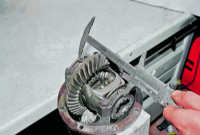
The calipers measure the distance between the covers and wrapping the second nut until it stops and reach it for 1-2 nut tooth. The distance between the covers should increase by approximately 0.1 mm; The rotation of the first nut set the desired gap in the engagement of 0.08-0.13 mm. This is the minimally tangible with your fingers in the engagement, accompanied by a slight knock of the tooth about the tooth; Hand controls the constancy of the size of the gap in the engagement and gradually tighten both nuts until the distance between the covers increases by 0.2 mm. This will provide the necessary tight of bearings.
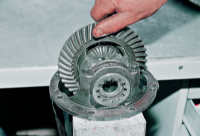
We slowly turn the driven gear for three turns and at the same time tack the backlash in the engagement of each pair of teeth. If it is uniform in all positions of the gears, we set the locking plates. The reduction (increase) of the backlash in any sector indicates the deformation of the differential body and the need to replace it or turn on the lathe. The locking plates are of two types: with one or two paws. Depending on the position of the slot of the nut set one of them.
Adjusting the Reducer VAZ 2107 on the back bridge ...
Welcome motorists of classic VAZ models in Avtoblog Site! In these videos, consider the reducer of the VAZ 2107 and adjustment. The video of Nikolai Vladimirovich dedicated to the owners of rear-wheel drive cars, as today the trend on the rear axle reducer. A visual manual for repair and adjustment showed a rear axle reducer VAZ 2107, common domestic car.
Consider the rear axle reducer ...
The main elements of the gearbox are the main transmission gears, these are the so-called "cone" and "planetary", which constitute the main pair of gearbox. The plant produced four options for main pairs:
- Pacific, installed on VAZ 2102. The pair has 9 teeth on the conical gear and 40 planetary. The number of torque is 4.44, this is a slower option. Removed from production;
- On the VAZ 2101 - the famous "penny", the main couple had 10 teeth on the "horse" and 43 on the "planetary", with gear ratio 4.3, removed from production;
- VAZ 2103, respectively, 10 teeth on the "horse" and 41 on the "planetary";
- VAZ 2106 - 11 teeth on the "horse" and 43 on the "planetary", the gear ratio 3.9 is considered a high-speed gearbox.
It should be noted that the main pair with a gear ratio 4.44 for the VAZ 2102 to spare parts, generally speaking, was not released and was intended only for the configuration of VAZ 2102 gearboxes on the factory conveyor.
Differential device
The planetary gear is attached to the differential body. The differential consists of two gear semi-axles, two satellites and a finger. The main, the most occurring differential faults are the wear of the satellite (backlash) and wear of the slots on gear gears.
On the car, the backrest of the satellites can be determined by turning cardanian Vala On a quarter or more, if there is no backlash, the shaft almost remains on the spot when trying to turn it into one direction or the other.
It is also worth noting that any noise never happens from differential. When moving forward (in a straight line), the differential rotates as one whole and it turns out that there is just nothing to noise.
The reason for the occurrence of noise from the rear axle gear when the gas is added and the noise disappearance after the gas discharge is (almost 99.9%) the wear of the main pair of teeth. On the removed reducer It is clearly visible. The part of the side of the teeth, which is used to move forward, has a significant wear, while the party for rear stroke Virtually not worn.
If, after disassembling and defecting the parts of the main pair, the wear of the teeth was detected, then no repair will not help and it will simply be a waste of time and finance. It is necessary only to replace the main pair.
Main-page
The gears of the main pair are selected at the factory for the spnow of contact, noise and other parameters and are marked. For example, the planetary gears are knocked out - VAZ 2103 (model), 10 41 (gear ratio), 4091 (pair number). The number of the main pair of 4091 is installed on the conical gear.
After labeling these parts, they became the "main pair" and are not installed alone without another, that is, "relatives". "Konichka" also applied "- 6", this is an amendment for assembling the main pair in the gearbox. When the differential defects are checked and its bearings are checked for their wear and, if necessary, be replaced. Often wear bearings provoke with an unprofessional replacement of the gearbox seal. For example, after replacing the gland, the shank nut is tightened without observance of the tightening torque (pull, how much power is) and the force is transmitted not to the spacer sleeve, but on the differential bearings.
As a result, noise reducer appears after the short mileage after replacing the shank gland. Only in this case the noise "Gul" in the gearbox is permanent and unlike the noise from the worn teeth of the main transfer. At the same time, the rumble is constantly, regardless of whether the gas is added or reset.
Assembling rear axle gear
Video 1:
Adjusting the gearbox using special devices and control devices ...
When assembling the gearbox is adjustable to the 4th parameters:
1. Selection of the adjusting ring
Parameters from 2.6 to 3.5. The ring serves to adjust the depth of the gear of the teeth "horse" and "planetary", which is strictly set. Here just need a "correction -6" for this main pair, which was mentioned above. Of course, for each main pair, this amendment will be individual.
In this video, the main pair adjustment will be performed using a special device. It is clear that the overwhelming number of motorists there is no such device and this is only a visual example of adjusting the gearing depth parameter. A variant will be given for adjustment without "adjustment".
The device also establishes "toa" with a micrometer that imitates the gear of the main pair. The indicator is set zero. Then the leg of the indicator is transferred to the bearing bed and in this case the indicator shows the value - 3.25, which is not good, as it should lie within - 3.0. On the second landing plane it turned out - 3.45. Average arithmetic - 3.3. For adjustment, we use the amendment on "Konichka" - "- 6". In this case (- 3.3) + (-6) \u003d 3.36. The thickness of the adjusting washer is necessary - 3.36 mm. With the help of a micrometer, pick the puck of the required thickness.
Note. With the wear of the bearing of the shank, it begins to turn on the body "Konichki". As a result, the end of the bearing, the adjusting washer and the body of the shank gear are wearing. It turns out that when replacing the shank gland, even at the right moment of tightening, adjusting the depth of the gear gears of the main pair and the "howling" pair is provided, as well as its fast failure.
Let's go back to the assembly of the gearbox ...
2. Adjusting the preload of the bearing shank
The shank bearing sits on the "horse" and a new spacer sleeve is installed. It is clearly seen on the video that the new sleeve is smooth without any deformation, and the previously stood deformed. The following occurs. When tightening the hatch of the shank prescribed torque (from 12 to 26 kgf), the sleeve takes over the tightening force and deforming works as a spring, creating a tension. The force of tightening the nuts of the gearbox of the VAZ 2107-E is significant and the shank must be fixed from turning.
On the video we see what "device" uses the master. It is necessary to delay the shank nut until the back of the backlash. For proper tightening The nuts of the shank must turn with the resistance force 0.3-0.4 kg, it became, the bearing preload is performed correctly. This rule when assembling is used for old (used) bearings.
The differential with bearings is established and fixed with covers (tightening torque of about 8 kgf) and adjusting nuts of differential bearings are bent.
3 and 4. Simultaneous adjustment thermal clearance Main pair and preload of differential bearings
For these purposes, the next "adapt" with two indicators is necessary. Adjusting nuts on the video well and everything is shown to conclude a planetary gear to the teeth "Konichki" seeking the required clearance. Factory clearance adjustment data from 0.08 to 0.12 mm. However, such a gap is provided for the new main pair ("Konichki" and "Planetary"). The clearance is checked in the 4-planes, turning the gear. The gap for the working major pair is after adjustment 0.13- 0.14 mm.
After adjusting the adjustment, the adjusting nuts warp the plates special for this, with one or two "assholes". This assembly and adjustment is completed.
Video 2:
Adjusting the depth of the main pair
Adjusting the rear axle gearbox with its own hands without using special devices (VAZ 2107 gearbox is the same).
In this case, it is necessary to choose the thickness of the adjusting washer.
So: instead of the device, we set the "native" shank and wrap the nut to the easy stop, leaving the gap. The differential with the planetary assembly is established, the bearing caps and the bolts of their mount are tightened.
Council - reminder ...
When replacing the shank gland, a number of incorrect actions are allowed, which ultimately lead to the output of the gearbox before time. Before releasing the hatch of the shank, according to the technology of performing the work on the replacement of the gland, it is necessary to remove the semi-axes (which is almost never running, since the amount of work will increase many times). Although according to the price list, the removal of the semi-axes is likely to be entered into the statement and the fee will be taken for it, as this requires the technology for the replacement of the gland. This is a prerequisite, since the semi-axis will create resistance when tightening and proper adjustment Just it will be impossible to achieve.
Before releasing the shank nut, it must be fixed from turning and the torque wrench to check the tightening force of the nut, in the region of 12 kgf. Before installing the gland, if its outer surface is not rubberized, then you need to use the sealant to warranty. So, the risk of 0.15 mm on the gearbox will be sufficient to pass the oil through the outer surface of the gland.
Back to the assembly ...
Adjusting nuts are set, and the gap is pre-selected on the main pair (the final gap 0.08 to 0.12 mm). Then the paint is applied to the teeth of the planetary gear from the aerosol canopy and with the shank it is necessary to perform a slight movement in different directions to fix the paint of the contact spot.
Now turning back the gear of the "planetary" gear is clearly seen a spot of contact on her teeth with teeth "Konichki". On the spot of contact (in this case) it can be seen that the adjusting washer on the shank is worth the greater necessary thickness. Click a little nut of the shank, thereby faving its bearing, which makes it possible to move the teeth gears to each other, that is, as it were, "reducing" the thickness of the adjusting washer. The adjusting nuts of the differential bearings are exhibiting an exemplary gap (slightly decreased).
Then we again put the paint on the teeth of the planetary gear and again begin to turn the shank (or gear) in different directions to print the contact stain between the teeth. It can be seen that the contact stain rose a little, but it is not enough and necessary to tighten the hatch of the shank again. Similar actions with paint and turning gears must be carried out until the contact spot is located exactly in the middle of the teeth, and the sound of the turning teeth will become quieter.
After the correct (final) audio adjustment will be practically sick.
Do not forget with each tightening of the shank nut tighten the adjusting nuts of the differential bearings. As a result, the contact stain is accurately over the entire surface of the teeth. It should be noted that this condition is the location of the contact stain for old (worked) pairs. For new main pairs of contact, as mentioned above, it should be located in the center of the teeth.
Further. The planetary attachment covers are given and the differential is removed. The shank nut is unscrewed and removed. Since the shank was put only with the bearing without an adjusting washer, then the gap remained between the bearing and the gear of the shank, where the washer. This gap is measured by a set of probe, thereby calculating the necessary thickness of the adjusting washer.
It turns out, as in the case of using instruments and devices, the size under the desired adjusting washer was also 3.36 mm. The shank bearing is removed, the adjusting washer (3.36mm) is set, the bearing is put in place and the gearbox is assembled. A shank is put, a shank nut is delayed, min 12 kgf. There is a differential with a planetary gear, covers and bolts are tightened, but not finally.
By the way, the covers cannot be confused by places. Adjusting nuts of the differential bearings are put and pre-gap on the main pair are set. Then, the bolts of the differential caps are dragged finally. The clearance in the main pair is finally adjusted and adjustment nuts are set.
Video 3 replacement of the gearbox in the back bridge:
On this, work on the assembly and adjustment of the Reducer VAZ 2107 ends.

